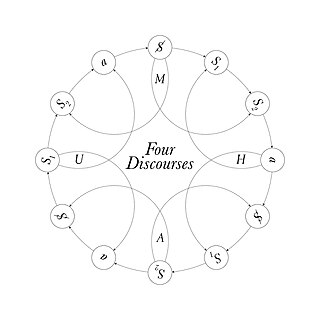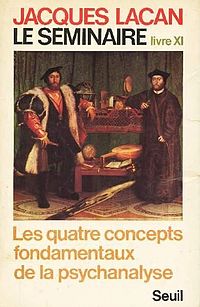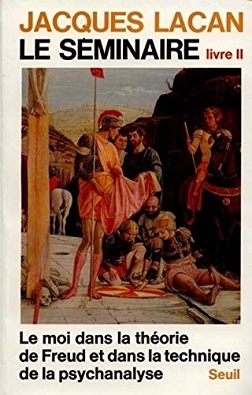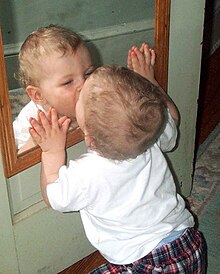
Jacques Marie Émile Lacan was a French psychoanalyst and psychiatrist. Described as "the most controversial psycho-analyst since Freud", Lacan gave yearly seminars in Paris, from 1953 to 1981, and published papers that were later collected in the book Écrits. Transcriptions of his seminars, given between 1954 and 1976, were also published. His work made a significant impact on continental philosophy and cultural theory in areas such as post-structuralism, critical theory, feminist theory and film theory, as well as on the practice of psychoanalysis itself.
Psychoanalytic literary criticism is literary criticism or literary theory that, in method, concept, or form, is influenced by the tradition of psychoanalysis begun by Sigmund Freud.
Psychoanalytic film theory is a school of academic thought that evokes the concepts of psychoanalysts Sigmund Freud and Jacques Lacan. The theory is closely tied to Critical theory, Marxist film theory, and Apparatus theory. The theory is separated into two waves. The first wave occurred in the 1960s and 70s. The second wave became popular in the 1980s and 90s.
Jouissance is a French language term held untranslatable into English.
Ego psychology is a school of psychoanalysis rooted in Sigmund Freud's structural id-ego-superego model of the mind.
Identification refers to the automatic, subconscious psychological process in which an individual becomes like or closely associates themselves with another person by adopting one or more of the others' perceived personality traits, physical attributes, or some other aspect of their identity. The concept of identification was founded by psychoanalyst Sigmund Freud in the 1920’s, and has since been expanded on and applied in psychology, social studies, media studies, and literary and film criticism. In literature, identification most often refers to the audience identifying with a fictional character, however it can also be employed as a narrative device whereby one character identifies with another character within the text itself.
In continental philosophy, the Real refers to the demarcation of reality that is correlated with subjectivity and intentionality. In Lacanianism, it is an "impossible" category because of its opposition to expression and inconceivability. The Real Order is a topological ring (lalangue) and ex-sists as an infinite homonym.
[T]he real in itself is meaningless: it has no truth for human existence. In Lacan's terms, it is speech that "introduces the dimension of truth into the real."

The Imaginary is one of three terms in the psychoanalytic perspective of Jacques Lacan, along with the Symbolic and the Real. Each of the three terms emerged gradually over time, undergoing an evolution in Lacan's own development of thought. "Of these three terms, the 'imaginary' was the first to appear, well before the Rome Report of 1953…[when the] notion of the 'symbolic' came to the forefront." Indeed, looking back at his intellectual development from the vantage point of the 1970s, Lacan epitomised it as follows:
"I began with the Imaginary, I then had to chew on the story of the Symbolic ... and I finished by putting out for you this famous Real."
The Symbolic is the order in the unconscious that gives rise to subjectivity and bridges intersubjectivity between two subjects; an example is Jacques Lacan's idea of desire as the desire of the Other, maintained by the Symbolic's subjectification of the Other into speech. In the later psychoanalytic theory of Lacan, it is linked by the sinthome to the Imaginary and the Real.

Four discourses is a concept developed by French psychoanalyst Jacques Lacan. He argued that there were four fundamental types of discourse. He defined four discourses, which he called Master, University, Hysteric and Analyst, and suggested that these relate dynamically to one another.
In Lacanianism, demand is the way in which instinctive needs are alienated through language and signification. The concept of demand was developed by Lacan—outside of Freudian theory—in conjunction with need and desire in order to account for the role of speech in human aspirations, and forms part of the Lacanian opposition to the approach to language acquisition favored by ego psychology.
Freudo-Marxism is a loose designation for philosophical perspectives informed by both the Marxist philosophy of Karl Marx and the psychoanalytic theory of Sigmund Freud. Its history within continental philosophy began in the 1920s and '30s and running since through critical theory, Lacanian psychoanalysis, and post-structuralism.

The Four Fundamental Concepts of Psychoanalysis is the 1978 English-language translation of a seminar held by Jacques Lacan. The original was published in Paris by Le Seuil in 1973. The Seminar was held at the École Normale Supérieure in Paris between January and June 1964 and is the eleventh in the series of The Seminar of Jacques Lacan. The text was published by Jacques-Alain Miller.
Self psychology, a modern psychoanalytic theory and its clinical applications, was conceived by Heinz Kohut in Chicago in the 1960s, 70s, and 80s, and is still developing as a contemporary form of psychoanalytic treatment. In self psychology, the effort is made to understand individuals from within their subjective experience via vicarious introspection, basing interpretations on the understanding of the self as the central agency of the human psyche. Essential to understanding self psychology are the concepts of empathy, selfobject, mirroring, idealising, alter ego/twinship and the tripolar self. Though self psychology also recognizes certain drives, conflicts, and complexes present in Freudian psychodynamic theory, these are understood within a different framework. Self psychology was seen as a major break from traditional psychoanalysis and is considered the beginnings of the relational approach to psychoanalysis.

In Freudian psychoanalysis, the ego ideal is the inner image of oneself as one wants to become. It consists of "the individual's conscious and unconscious images of what he would like to be, patterned after certain people whom ... he regards as ideal."
In Jacques Lacan's psychoanalytic philosophy, lack is a concept that is always related to desire. In his seminar Le transfert (1960–61) he states that lack is what causes desire to arise.
Identification is a psychological process whereby the individual assimilates an aspect, property, or attribute of the other and is transformed wholly or partially by the model that other provides. It is by means of a series of identifications that the personality is constituted and specified. The roots of the concept can be found in Freud's writings. The three most prominent concepts of identification as described by Freud are: primary identification, narcissistic (secondary) identification and partial (secondary) identification.
In psychoanalysis, foreclosure is a specific psychical cause for psychosis, according to French psychoanalyst Jacques Lacan.

The Ego in Freud's Theory and in the Technique of Psychoanalysis is the 1988 English-language translation of published in Paris by Le Seuil in 1977. The text of the Seminar, which was held by Jacques Lacan at the Hospital of Sainte-Anne in Paris between the Fall of 1954 and the Spring of 1955 and is the second one in the series, was established by Jacques-Alain Miller and translated by Sylvana Tomaselli.
Lacanianism or Lacanian psychoanalysis is a theoretical system that explains the mind, behaviour, and culture through a structuralist and post-structuralist extension of classical psychoanalysis, initiated by the work of Jacques Lacan from the 1950s to the 1980s. Lacanian perspectives contend that the human mind is structured by the world of language, known as the Symbolic. They stress the importance of desire, which is conceived of as perpetual and impossible to satisfy. Contemporary Lacanianism is characterised by a broad range of thought and extensive debate among Lacanians.






